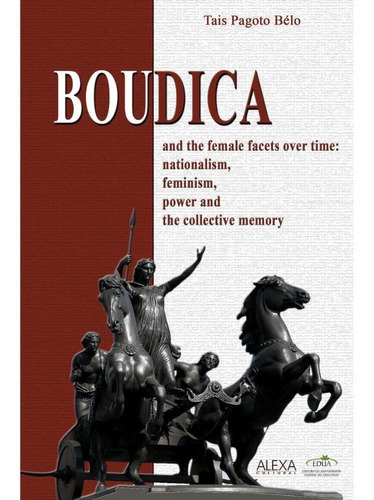Boudica And The Female Facets Over Time: Nationalism, Femini
em 12x
Estoque disponível
Confira a

Características principais
Título do livro | Boudica and the female facets iver time |
|---|---|
Autor | Tais Pagoto Bélo |
Idioma | Inglês |
Editora do livro | Alexa Cultural |
Outras características
Gênero do livro: Sociologia
Tipo de narração: Manual
Idade mínima recomendada: 18 anos
Idade máxima recomendada: 70 anos
ISBN: 9786599034275
Descrição
Boudica and the female facets over time: nationalism, feminism, power and the collective memory Tais Pagoto Bélo 14x21cm - 268 pages ISBN - 978-65-990342-7-5 This work is based on an episode from the history of Roman Empire, which occurred during the first century AD, more specifically 60/61 AD, in which a warrior queen, named Boudica or Boadicea, from the ancient Britannia – current England – was a protagonist and whose actions have provided consequences in social affairs up to our days. It is, therefore, a study of the first representative women-led movement claiming for liberty, as well as the demonstration of the uses of her figure in the Modern and Contemporary times, strengthening later social movements, such as the British suffragettes and creating a female icon that became reference to all other English women in power since then. In addition, the aim here is also to present how the usages of icons of the past can carry within themselves representations that are still valuable in the present, and that they can also undergo changes in their symbolic context, due to the value attributed to them by ordinary attitudes which make this past always to be remembered. In this way, a memory can be fed and become responsible for, from time to time, building and completing a collective memory that, according to Halbwachs (1996), is a stream of continuous of nothing artificial thoughts, which has nothing of artificial, since it retains from the past only what is still alive or capable of living in the consciousness of the group that holds it. Hence, where there is an experience, in the strict sense of the term, certain contents of the individual past come together in memory with others of the collective past (Benjamin, 1989, p. 107). In other words, one does not exist without the other. Furthermore, this work is also an commentary about the study of women, as well as its directions and difficulties whose scholars in this field have followed and faced in order to frame demands, movements and desires of women in the academic society. Thus, the usage of Boudica's figure over time is one of the reflexes of how British society depicted its own women. Nonetheless, these reflexes belong, in a certain way, to the whole of Western society. It was written to inspire not only the academic readers, but also everyone who becomes aware of the repercussion of the force and purposes of Boudica. If the consciousness and struggle of women in each historical period were explicit, and not simply omitted from humanistic studies over the years, we would have been acquainted with these remarkable females characters who, from their practices, formed actions, often repressed, fundamental to the momentum of the realization of a female group of individuals in a given space and time. This study is, therefore, not only a sketch on Boudica, but also an analysis of the representative conception of her figure in order to provide a better understanding on women and elucidate the national significance they possesses for the British. It also has as its background the rationalization of the British perception of the Nineteenth and the beginning of the Twentieth-century women, which followed its course in history with the nationalist discourses of the British Empire and understood the very remote beginning of the conception of gender and sexuality. In addition, the aim here is also to present how the usages of icons of the past can carry within themselves representations that are still valuable in the present, and that they can also undergo changes in their symbolic context, due to the value attributed to them by ordinary attitudes which make this past always to be remembered. In this way, a memory can be fed and become responsible for, from time to time, building and completing a collective memory that, according to Halbwachs (1996), is a stream of continuous of nothing artificial thoughts, which has nothing of artificial, since it retains from the past only what is still alive or capable of living in the consciousness of the group that holds it. Hence, where there is an experience, in the strict sense of the term, certain contents of the individual past come together in memory with others of the collective past (Benjamin, 1989, p. 107). In other words, one does not exist without the other.
